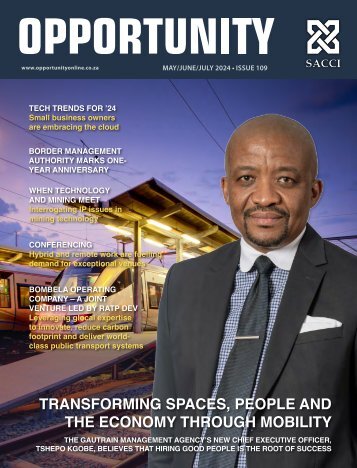South African Business 2016 edition
- Text
- Investment
- Government
- Business
- Development
- Network
- Sectors
- Investing
- Business
- Africa
- African
- Economic
- Manufacturing
- Mining
- Opportunities
- Economy
- Overview
OVERVIEW the stations
OVERVIEW the stations were isolated and did not run in conjunction with other forms of transport, like taxis and buses. The average age of the fleet was 40 years. This frustration led to vandalism and acts of outrage. The new programme had three phases: • 2007-2010 – Stabilize commuter rail by bringing all the different passenger railway networks into one; • 2011-2014 – Focus away from refurbishment to replacement; • 2015-2018 – Growth and expansion. Road National government has spent ever-increasing amounts of money on road allocations over the last five years, increasing at a rate of 16% every year. The South African National Roads Agency Limited (Sanral) has successfully raised billions of rands through bonds and capital markets in order to finance, manage and maintain the national road network of 16 750km. However, plans to pay for the Gauteng Freeway Improvement Project through tolling have run into political obstacles. At its inception, SANRAL only had about 7 000 kilometres under its jurisdiction, and has since grown by threefold. The portfolio comprises of a 15% toll-road and 85% non toll-road split. “The vast majority of the portfolio concerns non-toll-roads. The non-toll-road funding comes directly from National Treasury as for any other department. The significance of the national road network is that it carries 80% of the freight that moves on the surface of South Africa,” said Sanral CEO Nazir Alli. Currently the largest challenge facing our roads at the moment is funding. He explains that looking at the country’s entire road network of 750 000 kilometres, it is the 10th largest network in the world, of which only less than 1% are tolls. “On the entire network of South Africa we have a backlog on maintenance of R197-billion,” explains Alli. “Our challenge is figuring out how to catch up on this backlog, how to fund it, and how do we make sure that we service the areas and parts of the country which are under-serviced? “While at the same time, how does the South African government, with its constrained budget and limited resources also meet its challenges in terms of the social wage that we pay to people—how do we tackle that problem?” Asked whether the proposed e-tolls, that have been the subject of a heated civil debate, would be established to assist with funding, Alli explains that e-tolling would solely be a method of collection and that one must not confuse it with the principal and policy of tolling. “The principle has been well established in South Africa and affirmed in two different places. In 1996, in the White Paper on Transport, we said that tolling is an instrument that the government will use where it is necessary, as it is believed that it can assist in terms of meeting the challenges of the budget. Additionally, it is clearly stated in the National Development Plan that this is an instrument that we will use when needed,” says Alli. South Africa has 325 019 heavy-load vehicles and the road freight industry employs 65 000 drivers. Air Airports Company South Africa (Acsa) owns and operates the country’s 10 biggest airports. The company also manages SOUTH AFRICAN BUSINESS 2016 108
OVERVIEW airports in India and Brazil. A 10-year spending plan announced in 2013 allocated R50-billion to expansion and R20-billion to maintenance. OR Tambo International in Johannesburg caters for more than 17-million passengers every year, receives more than 105 000 arriving airtraffic movements and employs 18 000 people. The Cape Town International Airport has been expanded and improved. King Shaka International Airport (KSIA) opened north of Durban in 2010. Emirates is the international carrier to KSIA. Several airports have been mooted as possible regional freight nodes: Wonderboom Airport in Pretoria, Polokwane Airport in Limpopo and Mafikeng Airport in North West Province. Transporting minerals Transnet Freight Rail is beefing up the commodity corridors that ferry raw materials. Amounts include: R26-billion on improving the manganese line to Port Elizabeth from the Northern Cape. Transnet aims to deliver 11.7-million tons of manganese by 2018, substantially increased from the 4.8-million tons delivered in 2011. R29-billion to upgrade the iron-ore line that links Sishen (also in the Northern Cape) with the Port of Saldanha in the Western Cape. As much as R50-billion could be spent on the connection between existing coal fields in Mpumalanga (and new ones in western Limpopo) with the Richards Bay Coal Terminal. The South African Ministry of Transport has several agencies and businesses reporting to it: Air Traffic and Navigation Services Company, Airports Company of South Africa (Acsa), National Transport Information System, Road Accident Fund, South African Civil Aviation Authority, South African Maritime Safety Authority (SAMSA) and the South African National Roads Agency Limited (Sanral). SECTOR INSIGHT • The Harrismith Logistics Hub will become an inland port. • Acsa is operating in India and Brazil. 109 SOUTH AFRICAN BUSINESS 2016
- Page 1:
SOUTH AFRICAN BUSINESS 2016 EDITION
- Page 6:
CONTENTS Introduction CONTENTS Sout
- Page 10 and 11:
CREDITS Publisher Chris Whales Publ
- Page 12 and 13:
SPECIAL FEATURE South Africa A peri
- Page 14 and 15:
SPECIAL FEATURE In a year that saw
- Page 16 and 17:
SPECIAL FEATURE owes its existence
- Page 18 and 19:
SPECIAL FEATURE against water losse
- Page 20 and 21:
SPECIAL FEATURE Operation Phakisa h
- Page 22 and 23:
SPECIAL FEATURE late in 2014. The h
- Page 24 and 25:
SPECIAL FEATURE Understanding Afric
- Page 26 and 27:
INTERVIEW Job creation on track Ala
- Page 28 and 29:
SPECIAL FEATURE Business funding Th
- Page 30 and 31:
SPECIAL FEATURE in turn makes it ve
- Page 32 and 33:
SPECIAL FEATURE Contact: 012 394 18
- Page 34 and 35:
SPECIAL FEATURE Black Business Supp
- Page 36 and 37:
SPECIAL FEATURE The evolution of sk
- Page 38:
SPECIAL FEATURE providing TVET lear
- Page 42:
PROFILE FP&M Seta Facilitating and
- Page 45 and 46:
• The development of a national s
- Page 48 and 49:
FOCUS Champions of change Five dyna
- Page 50 and 51:
SPECIAL FEATURE The top law firms S
- Page 52 and 53:
SPECIAL FEATURE Keeping the BRICS t
- Page 54 and 55:
SPECIAL FEATURE Keeping BEPS in che
- Page 56 and 57:
SPECIAL FEATURE IPAP in action In 2
- Page 58 and 59:
FOCUS THERE’S NO END TO THE BENEF
- Page 60 and 61: INTERVIEW The riches of Africa awai
- Page 62 and 63: INTERVIEW and it could actually be
- Page 64 and 65: PROFILE ECIC exco profiles Profiles
- Page 66 and 67: INTERVIEW The hub of Africa Tim Har
- Page 69 and 70: Key sectors Overview of the main ec
- Page 71 and 72: OVERVIEW from the subsistence farme
- Page 73 and 74: OVERVIEW South Africa produces abou
- Page 75 and 76: South Africa’s looming energy gap
- Page 77 and 78: How will these resources be develop
- Page 79 and 80: Vall exclusive economic zone limits
- Page 82 and 83: OVERVIEW NEED PIC Mining The South
- Page 84 and 85: OVERVIEW Mineral beneficiation The
- Page 86 and 87: PROFILE The Council for Geoscience
- Page 88 and 89: OVERVIEW Energy The South African e
- Page 90 and 91: INTERVIEW Cummins South Africa Cumm
- Page 92 and 93: OVERVIEW Manufacturing Increasing m
- Page 94 and 95: OVERVIEW Automotive International i
- Page 96 and 97: OVERVIEW Automotive components Incu
- Page 98 and 99: OVERVIEW Chemicals and pharmaceutic
- Page 100 and 101: OVERVIEW Healthcare South Africa’
- Page 102 and 103: OVERVIEW Water Severe water restric
- Page 104: OVERVIEW Improving quality The intr
- Page 107 and 108: Our Vision is is “Quality water f
- Page 109: OVERVIEW 107 SOUTH AFRICAN BUSINESS
- Page 113 and 114: affords, while maintaining its envi
- Page 115 and 116: kets, except Australia. In Africa,
- Page 117 and 118: Rosebank, Johannesburg, renamed ‘
- Page 119 and 120: Trade with Africa Improved infrastr
- Page 121 and 122: FOCUS MTN plugs R1.2-billion into K
- Page 123 and 124: MTN rolls out fibre infrastructure
- Page 125 and 126: OVERVIEW community engagement. The
- Page 127 and 128: PROFILE For BEE Verification and is
- Page 129 and 130: OVERVIEW attracting and retaining c
- Page 131 and 132: OVERVIEW Small business is taken ve
- Page 133 and 134: Franchise Fund—an innovative plat
- Page 135 and 136: educating young people in fields th
- Page 137 and 138: OVERVIEW Management Plan has divert
- Page 139 and 140: hazardous waste is also not being c
- Page 141 and 142: INTERVIEW yourself up as a Tier 1 o
- Page 144 and 145: OVERVIEW Renewable energy South Afr
- Page 146 and 147: INTERVIEW Plenty of scope for solar
- Page 148 and 149: LISTINGS South African business org
- Page 150 and 151: LISTINGS South African National Gov
- Page 152 and 153: LISTINGS Department of Communicatio
- Page 154 and 155: LISTINGS Department of Human Settle
- Page 156 and 157: LISTINGS Department of Science and
- Page 158 and 159: OVERVIEW Regional overview: Eastern
- Page 162 and 163:
INTERVIEW Buffalo City on the rise
- Page 164 and 165:
OVERVIEW Regional overview: Free St
- Page 166 and 167:
OVERVIEW Regional overview: Gauteng
- Page 168 and 169:
FOCUS A Catalyst for Economic Devel
- Page 170 and 171:
FOCUS business people and tourists
- Page 172 and 173:
OVERVIEW Regional overview: KwaZulu
- Page 174 and 175:
OVERVIEW Regional overview: Limpopo
- Page 176 and 177:
OVERVIEW Regional overview: Mpumala
- Page 178 and 179:
The powerhouse of Africa Mpumalanga
- Page 180 and 181:
Mpumalanga: Key Sectors Mpumalanga
- Page 182 and 183:
Nkomazi Special Economic Zone The N
- Page 184 and 185:
INVEST IN THE PROVINCE OF THE RISIN
- Page 186 and 187:
OVERVIEW Regional overview: Norther
- Page 188 and 189:
OVERVIEW Regional overview: North W
- Page 190 and 191:
OVERVIEW Regional overview: Western
- Page 192 and 193:
FOCUS Khayelitsha - the power of to
- Page 194 and 195:
INDEX INDEX Abeco Tanks ...........
- Page 196:
ENSafrica.com ENSafrica | Africa’
Inappropriate
Loading...
Mail this publication
Loading...
Embed
Loading...






















































































































































